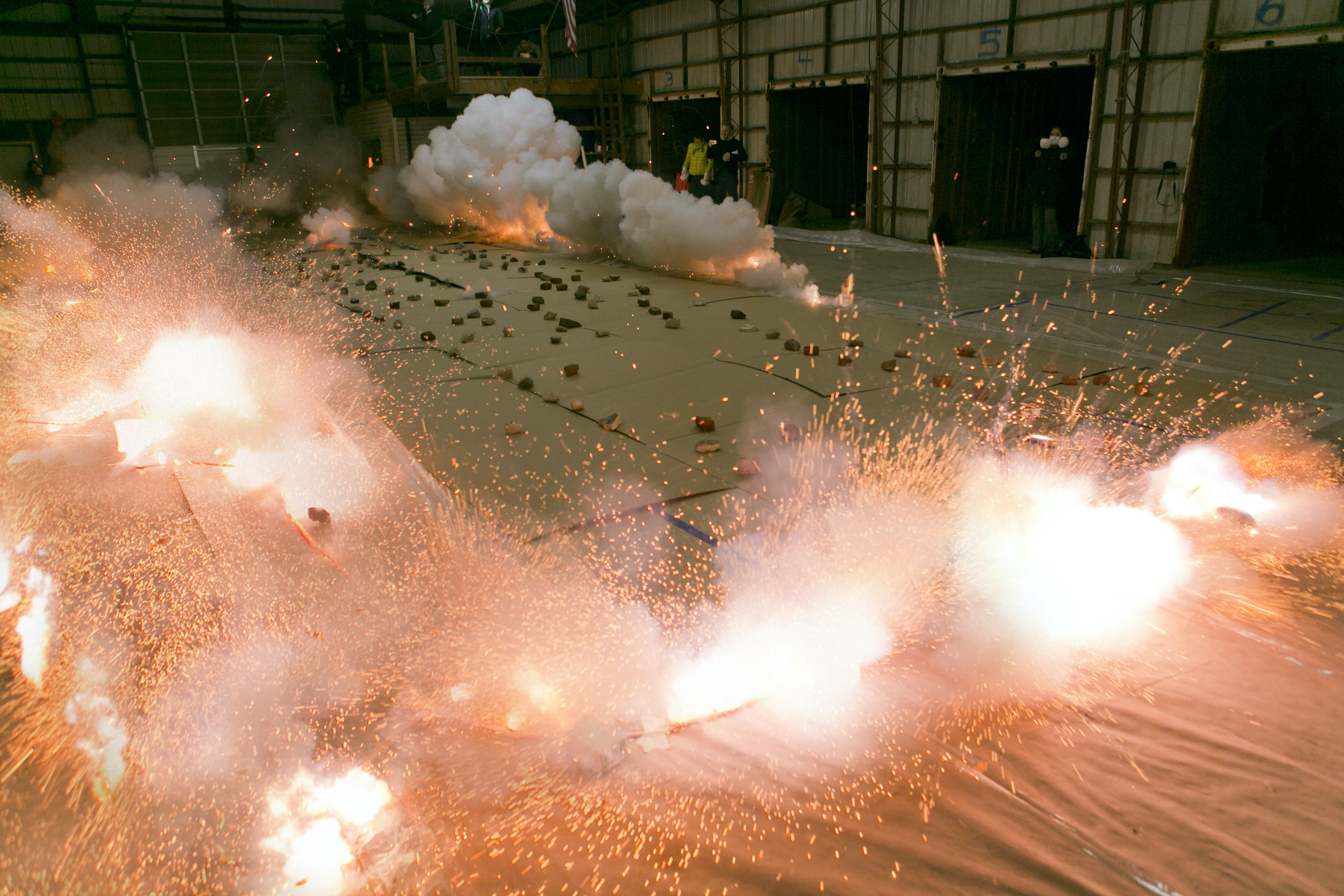LOS ANGELES — A large piece of white nylon stretches between two poles. Artist Gustav Metzger, donning a gas mask, sprays acid at the makeshift canvas. Over the course of his 10-minute film, “Auto-Destructive Art: The Activities of Gustav Metzger” (1965), on view in Gustav Metzger: And Then Came the Environment at Hauser & Wirth, the nylon’s previously taut, painterly surface is torn to shreds, revealing London’s River Thames beyond. Metzger’s usage of acid calls to mind both the “acid rain” produced by the mixture of toxic debris and rainfall, and the “black rain” that fell on Nagasaki and Hiroshima after the US detonated two atomic bombs in 1945; in one 2009 interview, the artist called the artwork an attack on “the systems of capitalism, but also inevitably the systems of war, the warmongers.”
Art and war, abstractly, is also the subject of Cai Guo-Qiang: A Material Odyssey at the USC Pacific Asia Museum. The two artists can easily appear to be opposites: Cai, born in 1957 in Quanzhou, China, produces work at a rapid pace, and his art is known for its spectacular, explosive displays, which typically use gunpowder as their primary material. Metzger, who died in 2017, was an outspoken pacifist who fled his Nuremberg home in 1939 on Kindertransport with his older brother; the rest of his family was killed in the Holocaust. Both artists, though, toe the fine line between creation and destruction, sometimes with real-life consequences: Cai’s recent performance, “WE ARE: Explosion Event” at USC’s Memorial Coliseum, which launched the Getty Foundation’s PST: Art and Science Collide initiative, drew criticism for its loud fireworks, smoke, and shrapnel, requiring a few visitors to receive minor first-aid treatment. Seen together in LA this fall, Cai and Metzger illuminate a central problem in art-making today: What happens when creative pursuits, in fact, destroy?
(1966/2021) (© The Estate of Gustav Metzger and The Gustav Metzger Foundation. All Rights Reserved, DACS 2024. Courtesy The Estate of Gustav Metzger and Hauser & Wirth, photo Keith Lubow)
And Then Came the Environment is Metzger’s first show at Hauser & Wirth since the gallery acquired his estate and foundation in 2020. The title is excerpted from his 1992 essay “Nature Demised,” which condemned corporate and governmental environmentalism for their a priori investment in mass production and capitalism. Metzger’s approach to the issues addressed in his writing is subtle and prescient, attuned to the ways scientific invention can simultaneously awe and harm. In one darkened gallery, the hypnotic “Liquid Crystal Environment” (1966/2024) displays a semicircle of seven floor-to-ceiling Kodak slide projections onto liquid crystal displays (LCDs). The work comes across like an allegory of global warming: the LCDs, composed from the same material in phone, computer, and radar screens, show oozing rainbows of color that morph based on the heat of the projector and the bodies in the room.
Metzger saw an intimate connection between art, society, and the environment: each was and is created and destroyed by toxic technologies and materials used in war, mass production, and gasoline-powered transportation. Cai takes a narrower view, but his work alights on the same connection between art and violence. In a series of paintings commissioned by the Guggenheim, on display at USC Pacific Asia Museum, he evokes the works of canonical Western artists using his typical explosive strategy. “Non-Brand 非品牌 2” (2019) shows Rothko-esque rectangles of red and orange gunpowder bifurcated by a thick black line, and “Non-Brand 非品牌 5” (2019) appropriates Yves Klein’s classic blue, now streaked with ash. These paintings render American and European artists inextricable from legacies of violence, while also connecting them to Chinese history — gunpowder was invented in ninth-century China.

But where Metzger’s auto-destructive work often resulted in the lack of art — spraying a nylon canvas with acid until it disintegrates, for example — Cai is prolific, and his artworks are the result of carefully engineered explosions that he himself has orchestrated. In his work, this destruction can reap celebration-worthy outcomes: “Gunpowder Study for October Revolution Centennial” (2017) displays a series of round, swirling bulbs of color, bleeding together to form an abstract, painterly canvas. The artwork’s careful, bright composition reveals an attention to the creative potential — and even aesthetic beauty — of violent revolution, like that of the Bolshevik’s overthrow of Russia’s Tsarist monarchy referenced in the title. Other works, though, portray deadly events in a more visceral, somber light: “Shadow: Pray for Protection” (1985–86), for instance, is a monumental canvas produced using gunpowder, wax, and acid, featuring ghostly, laser-cut stencils of human figures, their flesh singed by golden sulfuric gunpowder; the effect emulates the burned skin of Hiroshima victims.
It can be difficult to discern a legible moral position in Cai’s practice, but his work is often better for it, as his ambivalence successfully forces encounters with gruesome, uncomfortable truths about the connection between creation and destruction. He might do well, though, to take a page out of Metzger’s book. With only 18 works in his exhibition, including one film and two unrealized projects, presented as scale models, Metzger’s relatively limited oeuvre reflects an awareness of the art world’s unwitting contribution to “the demise of nature,” from the rapid, accelerating rate of artistic output to emission-intensive art fairs and international exhibitions. When I left Hauser & Wirth, the image of Metzger’s acid-drenched, torn-to-shreds nylon canvas hovered in my head — unsalable, un-transportable, unassailable. If Cai shows us what art truly is, then Metzger demonstrates what art can be.




Gustav Metzger: And Then Came the Environment continues at Hauser & Wirth (901 East 3rd Street, Arts District, Los Angeles) through January 12, 2025. The exhibition was curated by Kate Fowle.
Cai Guo-Qiang: A Material Odyssey continues at USC Pacific Asia Museum (46 North Los Robles Avenue, Pasadena, California) through June 15, 2025. The exhibition was curated by Rachel Rivenc, head of Conservation and Preservation at the Getty Research Institute.

